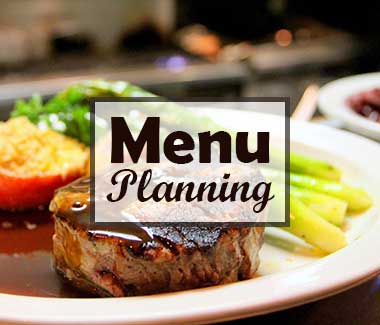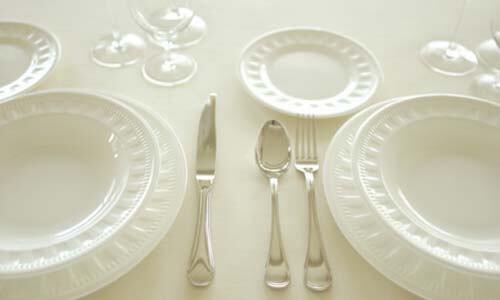
Tea Etiquette
Tea Etiquette Guide
Etiquette for Traditional Tea Service.The traditional time for afternoon tea is four o'clock. Today, most hotels and tearooms in North America serve from three to five o'clock.
Along with a choice of teas, there are three distinct courses:
- savones (tiny sandwiches) first,
- then scones, and finally,
- pastries.
Afternoon tea has also been called "low tea" because it was taken at low tables placed beside armchairs. (It's never properly referred to as "high tea".)
invitations
Invitations may be extended and accepted by telephone, face-to-face, or by mailing them at least a week in advance. Invitations may be informal or engraved, handwritten in calligraphy, or by a calligraphy font.
Invite a close friend or two also as "pourers" and set up a schedule of when each will be "on duty" dispensing tea. No one should pour for more than fifteen or twenty minutes. It is an honor to be asked to pour tea. The pourer is considered the guardian of the teapot, which implies sterling social graces and profound trust.
teatime
Traditional teatime is four o'clock; however any time between two and five o'clock may be appropriate.
guest of honor
Let your guests know whom you are honoring. When there is a guest of honor, it is your duty as host to stand with that person near the entrance of the room and introduce each arriving guest to the guest of honor. When the tea is over, guide your guest of honor back to the room entrance to say good-bye to your guests.
NOTE: Etiquette used to dictate that no one depart until the guest of honor had left. The exception was when the guest of honor was also a houseguest. Today, this rule is practically nonexistent.
The etiquette of the guest of honor departing first, however, is still practiced at diplomatic and official functions. At the White House, the guest of honor departs, then others are free to leave. This etiquette is practiced universally at events where world leaders are in attendance.
Tea equipment
If it is not a large formal tea, a silver tray and tea service are not necessary.
A china tea set consists of:
- a teapot,
- a creamer for the milk,
- a sugar bowl,
- a pitcher of hot water (for those who prefer weak tea), and
- a plate for lemon slices arranged on a wooden or tin tray are fine.
The tea tray and china tea set are placed at one end of the table.
On the right, set out the necessary number of cups and saucers and teaspoons.
Plates, flatware, and tea napkins are placed on the left.
Platters of refreshments can include tea sandwiches in fancy shapes, various kinds of nut breads, cakes, pastries, and cookies.
flatware
Flatware is necessary at teas in the following situations:
- When serving cake that is very soft and sticky or filled with cream, forks must be laid on the tea table.
- If jam or cream is to be eaten on scones or bread, there must be knives or butter spreaders.
- If there are dishes with jam and cream where everyone takes a portion, each dish should have its own serving spoon. Never use your own utensils to dip into the jam or cream dish.
When seated at a table in a private home or in a tearoom, there should be at each place setting:
- a knife or butter spreader on the right side of the plate and
- a fork on the left side.
- A teaspoon may be placed on the saucer holding the cup or to the right of the knife.
teacups
how to hold cups and saucers
Place the saucer holding the cup in the palm of your left hand and move it forward to rest on the four fingers, which are slightly spread apart.
Steady the saucer with your thumb resting on the rim. A left-handed person simply reverses the procedure.
A handled cup is held with the index finger through the handle, the thumb just above it to support the grip, and the second finger below the handle for added security.
The next two fingers naturally follow the curve of the other fingers. It is an affectation to raise the little finger, even slightly.
faux pas
the gaiwan
The gaiwan (Chinese covered cup) is held, when not drinking from it, very much like a teacup and saucer are held.
To drink from the gaiwan, use the thumb and index finger of your left hand to hold the lid by its knob, and let the other three fingers follow the curve of the gaiwan. Tilt the lid slightly away from your lips so that it serves as a filter holding back the leaves as you drink the liquid. The cup is never removed from the saucer.
faux pas
stirring a cup of tea
Stirring a cup of tea is done gently and noiselessly by moving the teaspoon in a small arch back and forth in the center of the cup.
- Do not allow the teaspoon to touch the sides or rim of the cup.
- Remove the spoon and place it on the saucer behind the cup, with the handle of the spoon pointing in the same direction as the handle of the cup.
- Visualize the face of a clock on the saucer and properly place the handle of the cup and the handle of the spoon at four on the clock.
faux pas
tea spills in your saucer
Tea spills may be remedied by requesting a clean saucer. In a very casual setting, it is acceptable to fold a paper napkin and slip it under the cup to soak up the liquid. Remove the unsightly soggy napkin from the saucer and place it on another dish if one is available.
You can prevent saucer spills by filling the teacup only three-quarters full.
napkins
The napkin is picked up and unfolded on the lap, not above the table level. A large dinner napkin is folded in half with the fold facing the body, while a luncheon or tea napkin may be opened completely. In upscale restaurants, the wait staff may place the napkin on your lap. Pause for a moment to make sure you and the wait staff do not reach for the napkin simultaneously.
If you need to leave the table temporarily, place your napkin on your chair, not on the table. Push your chair back under the table if the setting is appropriate.
In upscale restaurants, the wait staff will refold the napkin and place it on the table to the left side of your plate or on the arm of your chair. Return the napkin to your lap when seated.
The host or hostess picks up his or her napkin to signal the close of the tea. He or she makes certain all of the guests have finished before making this move.
At the end of the tea, the napkin is not refolded but picked up by the center and placed loosely to the left of the plate.
faux pas
tea infuser/filter, tea strainer, mote spoon, and caddy spoon
Tea infusers / filters are used to contain the leaves and permit easy removal of the used tea leaves. Some teapots are fitted with infusion baskets, also called filters. Be sure to give the leaves inside room to expand in the water when using the stainless-steel wire-mesh infusers, called "tea balls." Use two tea balls in making a six-cup pot.
Tea filters work best because they allow a lot of water to circulate without releasing the leaves into the brew.
Tea strainers are designed to be held above or to rest on top of the cup to catch leaves that escape from the teapot when the tea is poured.
A mote spoon or mote skimmer is usually made of silver with holes in the bowl. It is used to transfer tea leaves from the caddy to the teapot and also to skim off any stray leaves, or "motes," that may have escaped into the cup. The sharp point on the end is used to unblock the teapot spout if it gets clogged with tea leaves.
Caddy spoons have short handles so they will fit in the tea caddy. They are used to convey the tea from the tea caddy to the teapot.




